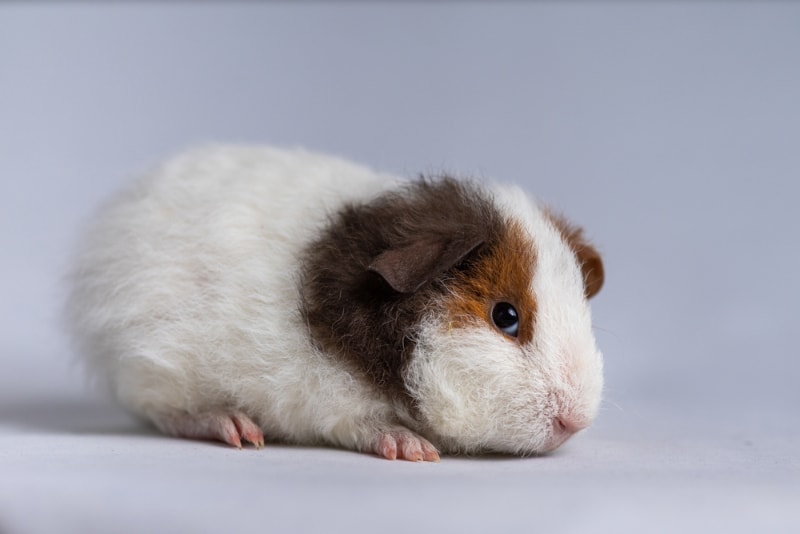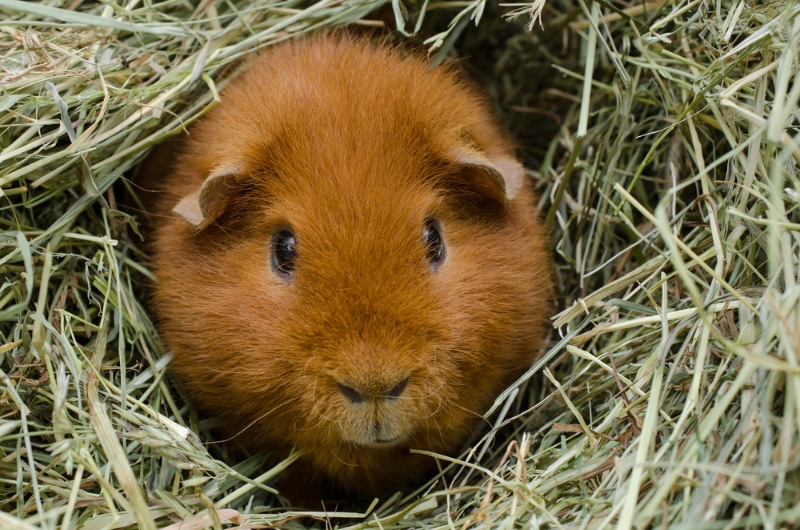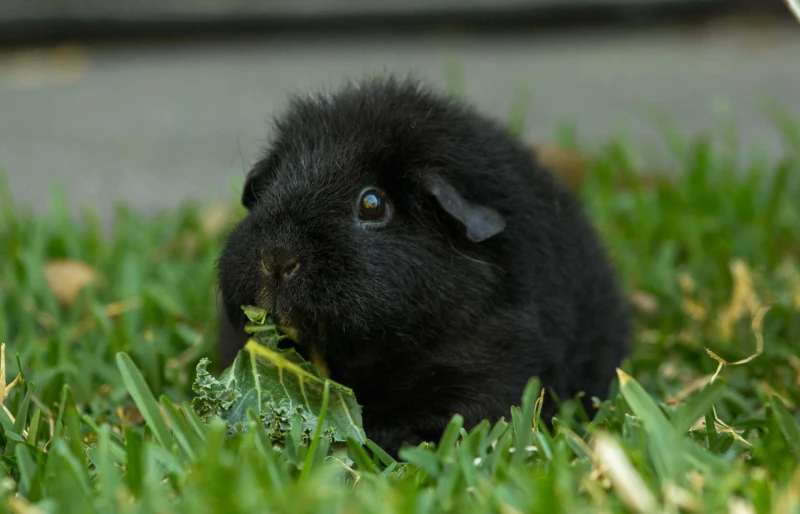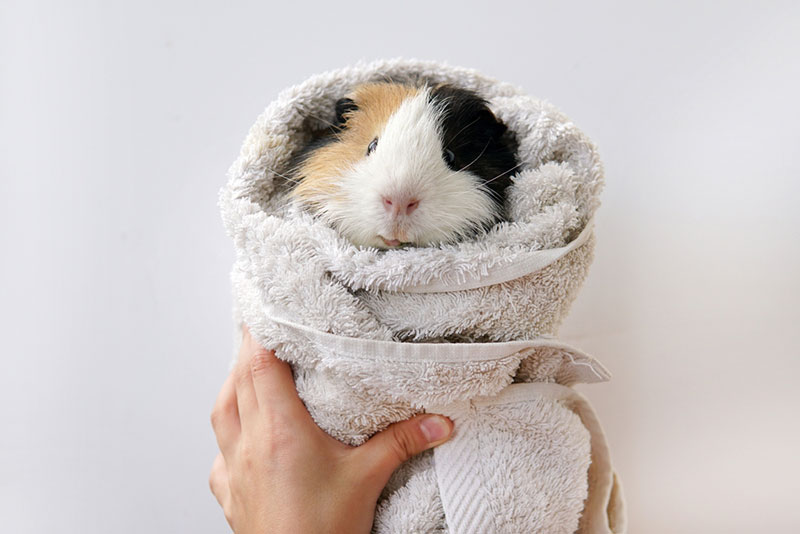Teddy Guinea Pig: Pictures, Lifespan, Behavior, & Care Guide
Updated on

Click to Skip Ahead
The teddy guinea pig is a sociable, curious creature that tends to enjoy the company of human companions. This breed is standard in size, so they’re large enough to handle hands-on interactions yet small enough for children to gently grasp without the worry of an accidental dropping. These guinea pigs have dense coats of hair that are typically medium-length and shiny and resemble the fur of a teddy bear, hence their name.
Their hair is possibly due to a genetic mutation that doesn’t have a negative effect on their overall health. Even though they are sociable animals, teddy guinea pigs are happy to spend time alone, making them suitable pet options for those who spend most of their time away from home during the week. Read on to learn more about this interesting and lovable pet rodent.
Breed Overview
| Size: | Standard |
| Weight: | 2–2.6 pounds |
| Lifespan: | 4–8 years |
| Similar Breeds: | Sheba, Merino, Himalayan |
| Suitable for: | New and experienced guinea pig owners |
| Temperament: | Relaxed, friendly, playful, explorative |
All guinea pigs come from South America. It’s thought that they were domesticated by humans thousands of years ago, though for a long time, they were not considered pets. Instead, they were raised for food and hailed as awesome gifts to peoples’ gods. Today, they are considered excellent pets because they enjoy the company of humans, and they happen to be good with children.
Teddy guinea pigs should live in a large, enclosed habitat made of glass or wire to maintain their safety throughout the day and night. These hardy animals can get used to handling quickly, but they are still known to nip at people when they feel unsafe and/or threatened. Therefore, children should be supervised until they know how to properly treat their pet guinea pig.
Teddy Guinea Pig Characteristics
How Much Do Teddy Guinea Pigs Cost?

Teddy guinea pigs range in price depending on whether they’re being purchased from a breeder or adopted from an owner or rescue center. You can expect to spend around $30 on a teddy guinea pig from a breeder. Some breeders price their animals a little lower or higher than this. A rescue organization may offer their guinea pigs for free or a small rehoming fee of $10 to $20. An owner looking to rehome their pet teddy guinea might charge anywhere from nothing to hundreds of dollars, especially if the pet comes with equipment like habitats and toys.
Temperament & Intelligence of the Teddy Guinea Pig
The typical teddy guinea pig is outgoing, sociable, and curious if they are used to interacting with and being handled by humans. They are even known to squeak in excitement when their human companions come home or toward their habitats for a visit. If they live with roommates, they are likely to chatter with each other throughout the day, reminding everyone else in the house of their presence.
When not active, most teddy guinea pigs can be found snoozing in a cave in their habitat or under a blanket on the couch. These playful animals are prone to turning anything into a toy, be it a toilet paper roll, a slice of apple, or an old sock. Teddy guinea pigs are often full of joy and love to be affectionate with their companions.
Do These Guinea Pigs Make Good Pets?
Guinea pigs can make excellent pets for children and adults alike. These are easier pets to care for than dogs, but they still require daily care and maintenance, which can help teach kids responsibility. These friendly animals like to explore and play, making interaction with them great fun for most people.
They enjoy being stroked and cuddled, which is known to reduce stress and lower blood pressure levels, and this can be beneficial for all teddy guinea pig owners. These animals also happen to be okay with spending the day at home alone when their human companions are at work, school, and out socializing.

Does the Teddy Guinea Pig Get Along With Other Pets?
The teddy guinea pig can get along well with other guinea pigs, but they aren’t interested in having anything to do with cats or dogs for the most part. Of course, there are always exceptions. If a dog or cat enjoys the company of a guinea pig, there is a chance that the guinea pig would be receptive to that. It’s always best to play it safe, though, and make sure your guinea pig is always safely separated from other animals in the house.
Things to Know When Owning a Teddy Guinea Pig
Food & Diet Requirements
Teddy guinea pigs are considered herbivores and require timothy hay or alfalfa to stay nutritionally fulfilled. These animals should also eat a commercial pellet food made specifically for guinea pigs. Your teddy can eat about 1 cup of fresh veggies and a small amount of fruit each day. Suitable options include:
- Romaine lettuce
- Red and green leaf lettuce
- Kale
- Cilantro
- Parsley
- Broccoli
- Bell peppers
- Carrots
- Zucchini
- Tomatoes
- Sweet potatoes
- Apples
- Strawberries
- Blueberries
- Oranges
- Grapes
Hay should make up about 80% of a teddy guinea pig’s overall daily diet. It should be available throughout the day so it can be grazed on. Fruit should make up only about 5% of their diet, while vegetables can make up the other 15%.

Habitat Requirements
A single teddy guinea pig should live in a habitat that provides at least 7 square feet of floor space. A cage that measures 42 x 24 inches in size should be the minimum. Add at least 2 square feet of floor space for each additional guinea pig living in the habitat. We recommend a habitat that’s at least 18 inches in height.
A guinea pig’s habitat can be made of either wire, glass, or plastic. No matter what the material is, ventilation is of the utmost importance. Any habitat made of solid material should have an open top that is covered with mesh. The habitat should be kept in a space that maintains a temperature of between 65 and 75 degrees Fahrenheit. The habitat should be outfitted with:
- Bedding — An absorbent substrate should cover the entirety of a teddy guinea pig’s habitat floor. Suitable options include fleece cage liners, shredded paper, and wood shavings.
- Food Dish and Water Bottle — These should be placed away from sleeping and activity areas.
- Hideout — A small cave or something similar offers a teddy guinea pig a quiet place to retreat for resting.
- Toys — Various commercial toys and objects like toilet paper rolls, apple tree branches, paper bags, and even old socks are all great options.
Exercise & Sleeping Needs
Like all guinea pigs, the teddy variety requires regular exercise to stay happy and healthy throughout their lives. In addition to having plenty of room to run around, explore, and play inside their habitat, each teddy guinea pig should get outside of their habitat for at least 1 hour of exercise each day. Guinea pigs can run around in a playpen or something similar if owners are not comfortable with them running around the house. Human interaction with toys is a great way to encourage daily exercise.
When it comes to sleeping habits, most teddy guinea pigs are awake for a large part of the day and sleep at night. Some like to nap during the day and remain active at night. It all depends on things like the household schedule, temperament, and preferences.
Training
Guinea pigs are smart animals, so the teddy can be trained to a certain extent. By utilizing food as a reward during training sessions, a teddy guinea pig can be taught tricks like coming when called, properly using toys, and turning around in circles. These little animals tend to learn fast and will follow their peers, so teaching one guinea pig a trick is often all that it takes for every animal in the group to learn said trick.

Grooming
Guinea pigs generally maintain their own hair, but they should be brushed once or twice a week to keep shedding to a minimum. Brushing sessions offer the perfect opportunity to look for problems like skin irritation, lice, and bumps that might mean it’s time to see a veterinarian. No bathing is necessary unless the hair gets soiled, and even then, it must be done carefully.
Lifespan and Health Conditions
The average teddy guinea pig lives for between 4 and 8 years depending on their health, their living situation, and their quality of life overall. While guinea pigs are generally healthy when well cared for, there are certain health problems that they’re susceptible to.
- Ear infections
- Abscesses
- Urinary problems
- Skin diseases
- Gastrointestinal stasis
- Scurvy
- Reproductive disease
- Tumors
Male vs. Female
Male teddy guinea pigs are usually larger than their female counterparts. They also tend to be more dominant, territorial, and vocal. Otherwise, there are no serious differences between male and female teddy guinea pigs.
3 Little-Known Facts About the Teddy Guinea Pig
1. They Have Extremely Dense Hair
Teddy guinea pigs have extremely dense hair to help protect their bodies from the elements. For this reason, they may shed quite a bit. Fortunately, regular brushing can help keep the shedding under control.
2. They Come in a Few Different Colors
These little furry rodents come in a variety of colors, including cream, gold, lilac, beige, brindle, and black. Some are multicolored! Whatever their color, one thing that they all have in common is the same coat texture.

3. They Chew on Each Other’s Hair
Most teddy guinea pigs chew on each other’s hair for a couple of reasons. First, doing so helps file their teeth down, as these never stop growing. The second reason is to groom each other. So, unless the hair chewing results in bald patches, this behavior is nothing to worry about.
Final Thoughts
The teddy guinea pig is cute, cuddly, friendly, and sociable—all of which are great traits for a household pet. They get along well with children and adults alike, and they can be quite entertaining due to their playful temperament. They do require daily care and plenty of love, so having one as a pet is still a big responsibility to take seriously.
Featured Image Credit: Wirestock Creators, Shutterstock












